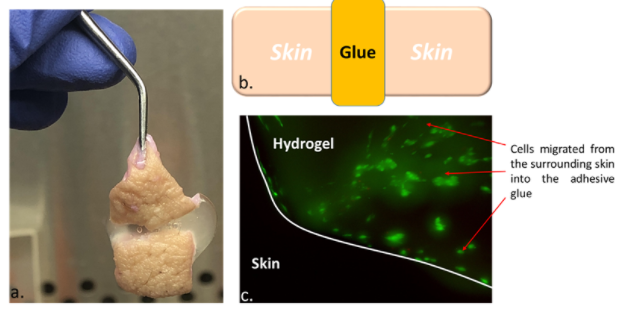Multi-faceted glue for long-term survival of osseointegrated prosthetic devices
A multi-functional photopolymerizable glue that enhances the physical and biological adhesion between soft skin and a metal prosthetic device.


Applications
-
Prosthetic device - adhesive
- Adhesive interface for osseointegrated percutaneous devices such as orthopaedic limb prostheses, dental implants, or bone-anchored hearing aids
Key Benefits & Differentiators
- Biologically-derived, biocompatible adhesive improves attachment of skin to metal implants
- Photo-polymerizable glue allows incorporating peptides that support migration, attachment and proliferation of epidermal cells; enhances innate wound-healing response around the percutaneous implant.
- Bioactive hydrogel scaffold can be loaded with active ingredients to prevent infection, activate cellular adhesion, etc.
- Easy to administer; no topographic modification to implants
Overview
Osseointegrated (OI) prosthetic devices were designed to overcome the limitations of press-fit socket devices and to improve life quality of limb amputees. Despite substantial progress made in optimizing implant design, surgical techniques and post-surgery rehabilitation, limitations such as implant associated infection and poor sealing at the skin interface have prevented widespread use of OI prosthetic devices. A recent meta analysis found that deep infections resulting in implant loosening occurred in up to 29% of patients. These infections can thereby affect implant longevity, residual limb health and function, and in particular, widespread usage of the OI implants. Current approaches to address these issues involve altering the surface topography of the metal implant or biomimetic coatings but with limited success.
Researchers at the University of Minnesota have developed a multi-functional photopolymerizable glue that enhances the physical and biological adhesion between soft skin and an Osseointegrated metal prosthetic device while reducing infection rate. When applied between the material of the prosthetic device and skin, this visible light polymerizable glue strengthens the skin-implant interface. Enhanced interface adhesion, in turn, improves the wound healing process and leaves the site of surgery less vulnerable to infection. One of the active materials used in this glue supports the release of cytokines from keratinocytes, which are key for supporting wound healing without the need of additional growth factors. Furthermore, antimicrobial peptides incorporated into the glue through silicate nanostructures provides an additional, prolonged line of defense against infection until a stable seal can be achieved.
This technology offers an opportunity to use a biocompatible bioactive adhesive that can provide a porous mechanical buffering scaffold which will thereby support skin tissue attachment to the metal surface. Additionally, the application of this glue does not require any alteration to existing materials but only an additional step of applying the glue during the surgical procedure. This technology can be easily used for prevention of failure by infection of other transmucosal implants and devices, such as dental implants.
Phase of Development
TRL: 3In vitro testing has been completed.
Desired Partnerships
This technology is now available for:- License
- Sponsored research
- Co-development
Please contact our office to share your business’ needs and learn more.
Researchers
- Conrado Aparicio, PhD, MSc Eng, Professor, Department of Restorative Sciences
- Isha Mutreja, PhD, MSc, Research Assistant Professor, School of Dentistry